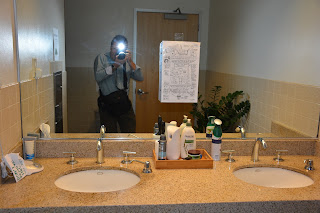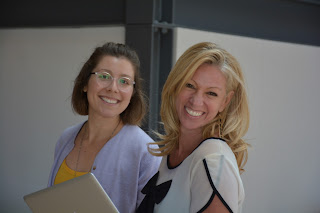The Association supports a diversity of membership, and that diversity is certainly part of its strength - but also one of the key things that attracts me to the association. In addition to architects, landscape architects, project managers, school principals, business managers and educational administrators; the association's membership also includes professionals in state government, catholic and independent school systems, product suppliers and manufacturers - all of whom contribute to the development of quality learning environments.
I became aware that A4LE was holding its American conference in Philadelphia while I was to be in the US and so I prioritised attendance at the conference (having attended a number of Australian events - all of which were high quality).
Attendance at the conference saw me catching the AMTRAK train from Penn Station in New York down to Philadelphia each day and then returning each evening - one way the trip was just over an hours and fifteen minutes. There's lots to be said for train travel in the states with a very efficient ticketing and loading and unloading of passengers at Penn Station. Philadelphia station is a beautiful established building that houses a dominant statue that salutes fallen soldiers - the Angel of the Resurrection.
As anticipated, attendance at the conference was a diverse schedule including school visits, challenging keynotes and engaging workshops.
Day 1 - school visits
We were specifically visiting Delaware to look at the STEM Centre. Opened in 2010, the STEM Center was designed to promote the latest trends in STEM education, including small-group collaboration, hands-on learning, the use of multimedia tools, smaller class sizes and cross-disciplinary approaches. With brightly coloured interiors, light-filled rooms and large windows, the Center offers a stimulating environment for learning. The Center was created as part of the College’s commitment to facilities redesign and infrastructure upgrade.
Operating since 1967, Delaware County Community College is a Middle States-accredited, associate degree granting institution that maintains a policy of open admission, providing academic excellence to anyone who can benefit from its programs. The College ranks sixth in size among the eighty-plus colleges and universities in the Philadelphia region.
Springfield Literacy Center
The Springfield School District is proud to have built the Springfield Literacy Center, the first new school constructed in Springfield in more than 50 years. The school houses all the kindergarten and first grade children from Springfield and Morton. The building has won several architectural and environmental awards and is the foundation of Springfield’s Literacy First initiative by which every child leaves elementary school reading on grade level.
Episcopal Academy
Episcopal Academy has been in existence for more than 200 years currently located on its third site.
Initially an all-boys school, The Episcopal Academy offered a curriculum focused on classical languages, religion, and mathematics. Trustees included two signers of the Declaration of Independence.
Originally and all boys school, the shift to coeducation was the product of years of strategic planning. Girls were admitted to Devon’s kindergarten class in 1974, and were added to each year’s incoming class thereafter until the school was fully coeducational. The first coeducational class graduated from The Episcopal Academy in 1984.
A 123-acre tract of land in Newtown Square is the home of the current campus. The land was purchased with a $20 million donation, and the $212.5 million campus project would be completed in time to open for the 2008-2009 school year.

The Newtown Square campus boasts state-of-the-art academic, arts, athletic, and spiritual facilities. However, it also features keepsakes from the previous campuses: original stained glass windows in the Class of 1944 Chapel, the clock that currently stands on the Clark Campus Green, and several other artefacts.
Today, students enjoy a curriculum that includes Advanced Placement (AP) classes, opportunities to study abroad, interdisciplinary study, and online courses with internationally renowned faculty. They are enriched by arts, athletics, and spiritual programs.
Upper Dublin High School
Upper Dublin High School has an enrolment of 1600 Students and over 3 phases was constructed at a cost of US$97.3m.
It boasts an indoor pool and a state of the art performing arts centre.
It was interesting to hear of the process required by school boards to undertake in gaining approval for such capital projects. The Board of School Directors is a nine member political body elected by the residents of the Upper Dublin School District. The superintendent and district solicitor also sit on the board, but are non-voting members.
All the local schools districts in Pennsylvania ((except Philadelphia) - Upper Dublin sits outside Philadelphia district as I understand it) are fiscally independent and are supported through local and state tax revenues and financing.
The School District of Philadelphia is fiscally dependent. All other districts have their own taxing authority to raise funds for capital outlay.
To secure approval for a capital outlay of this magnitude, School Boards go to the community with a referendum and the community needs to approve the capital outlay - which often requires a redistribution of or new collection of taxes.
Its interesting to seek to understand the national aspirations and local state approaches to curriculum design I think:
In 1999, the Pennsylvania State Board of Education adopted Rules and Regulations known as Chapter 4. This regulation was developed to establish concise and comprehensive educational offerings for public schools. Chapter 4 contains academic standards that identify the knowledge and skills students should learn in content areas by designated grade levels. The Pennsylvania Academic Standards, along with national standards, are incorporated into Upper Dublin’s curriculum development and revision process.
The goal is to hold all students to higher levels of performance by transforming Upper Dublin schools into communities of learners where all students experience a rich and challenging curriculum.
Chapter 4 regulations developed Pennsylvania’s Core Standards in English Language Arts and Mathematics, as well as for Language Arts and Literacy in History/Social Studies and Science/Technical Subjects and were adopted in 2014.
A group of Pennsylvania educators crafted the PA Core Standards, which mirror the academic rigor of the Common Core State Standards, set expectations in English Language Arts and Mathematics that all students should master by the end of each grade level.
The PA Core Standards are designed to be robust and relevant to the real world and reflect the knowledge and skills young people need to succeed in life after high school, in both post-secondary education and a globally competitive workforce.
Transitioning from existing state standards to the PA Core Standards had the following impacts:
- represented a shift in instructional intent from high school completion to college-and-career readiness for every student
- required students to demonstrate mastery of content, which cannot be acquired solely through lecture
- emphasized application and higher-order thinking skills
- at each grade may cover fewer topics; yet, content is taught in much greater depth.
REF: http://www.udsd.org/departments/curriculum/curriculum/#toggle-id-1

















































